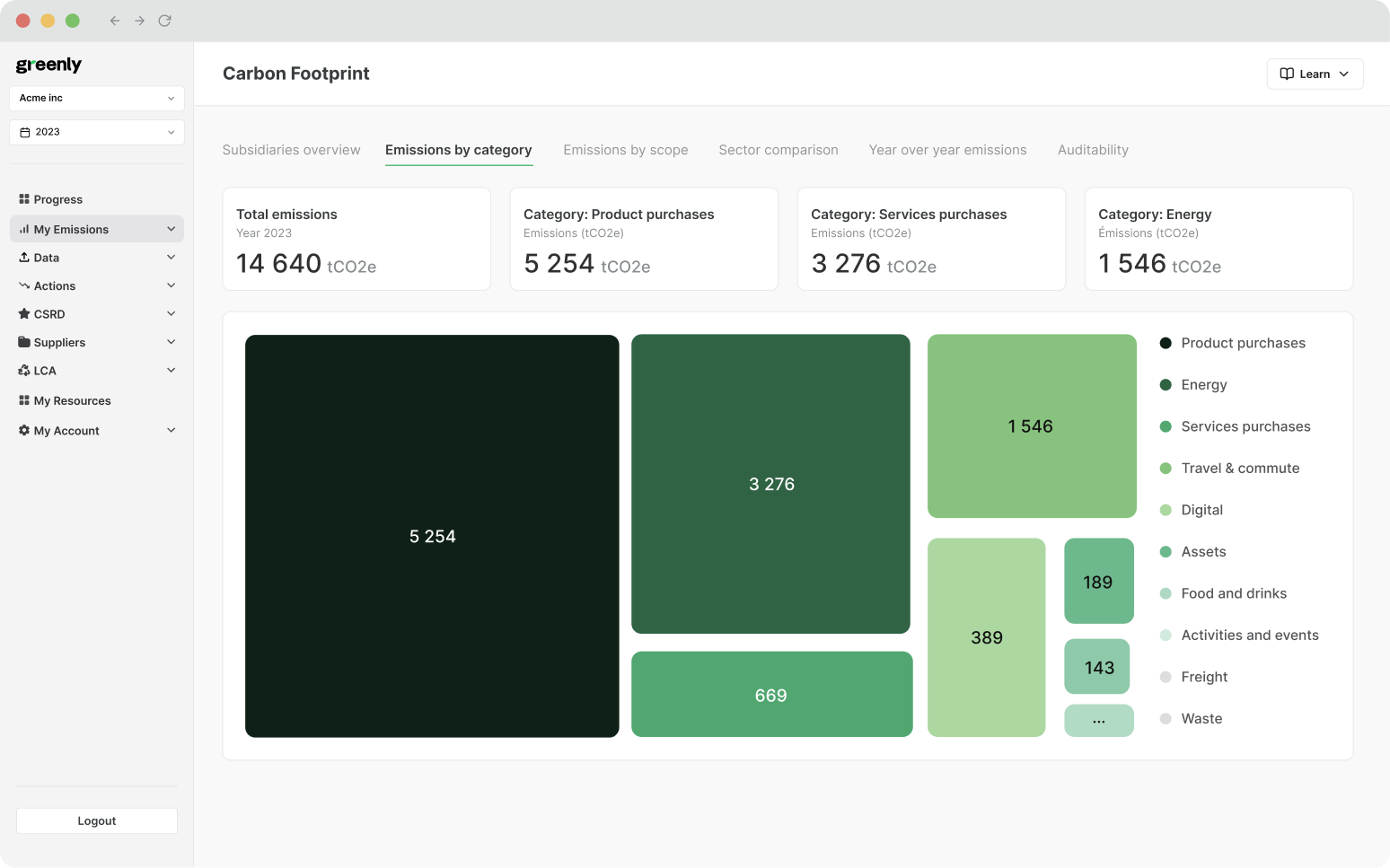
What are the 3 Pillars of Corporate Sustainability?
In this article, we'll explore what the 3 pillars of corporate responsibility are, why they're important, and how businesses can turn them into practical action.
ESG / CSR
Industries
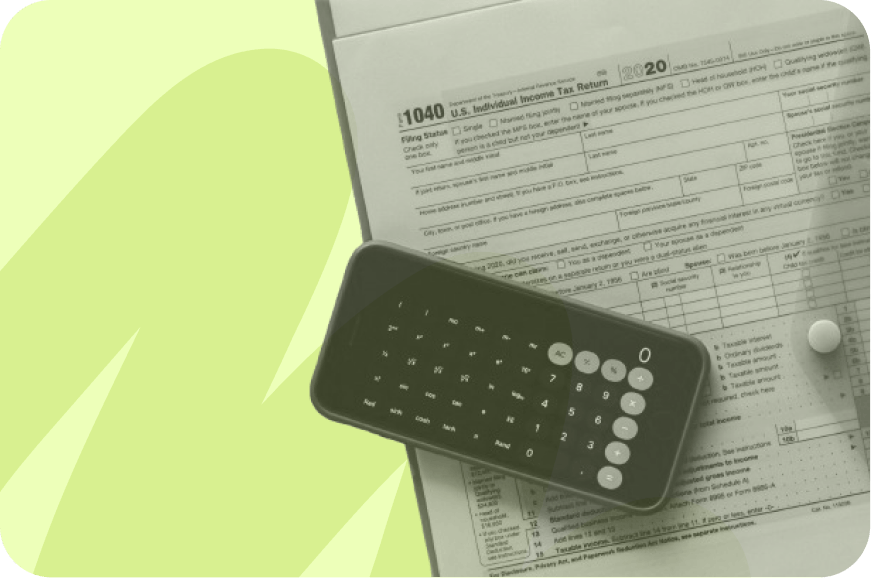


As businesses face increasing pressure to reduce their carbon footprint, the demand for reliable carbon management software has never been higher. With growing regulations, heightened expectations from stakeholders, and the urgent need to address climate change, measuring and managing carbon emissions is now a critical task for companies worldwide.
According to a 2023 CDP report, over 18,000 companies now disclose environmental data, revealing the growing global interest in carbon transparency – which requires collecting carbon data and utilising carbon accounting software.
Carbon management software refers to specialised platforms designed to help businesses measure, monitor, and reduce their carbon emissions. These tools automate the complex process of calculating carbon footprints, providing businesses with a clear overview of their greenhouse gas emissions across all operations. By tracking emissions from direct sources (Scope 1), purchased energy (Scope 2), and even the more challenging supply chain and indirect emissions (Scope 3), carbon management software offers a comprehensive view of a company’s environmental impact.
The right carbon accounting software or leading carbon accounting platform can be selected by evaluating its current features, market presence, user-feedback, and effectiveness of sustainability initiatives. This article includes both independent tools and one developed by Greenly.
Move your cursor over the interactive flip cards to discover the benefits of carbon accounting software:
Carbon accounting solutions such as Greenly provide user-friendly, intuitive dashboards that can allow companies to more easily ensure precise carbon emissions calculations in addition to various carbon accounting tools such as:
These platforms not only streamline compliance with international frameworks like the GHG Protocol and ISO 14064 but also help businesses in setting science-based decarbonization targets. By providing insights into where emissions are coming from and suggesting actionable steps for reduction, carbon management software plays a crucial role in the fight against climate change.
Measuring emissions is no longer optional for businesses – it’s strategic and legally imperative. As climate change accelerates, companies are being held accountable for their environmental impact by customers, investors, and regulatory bodies.
According to the World Economic Forum, a staggering 90% of global GDP is now covered by net-zero commitments, demonstrating the increasing incentive for companies to disclose their corporate carbon footprint, accelerate sustainability progress, and set emission reduction targets.
But why is it so important for businesses to measure their carbon emissions?
Here’s why tracking emissions and adopting carbon management tools is essential for businesses committed to ESG goals and long-term sustainability:
Governments and international bodies are introducing stricter regulations to ensure businesses reduce their greenhouse gas emissions. Frameworks like the GHG Protocol and the EU’s CSRD (Corporate Sustainability Reporting Directive) require companies to provide detailed reports on their emissions. Carbon management software helps businesses stay compliant by automating data collection and ensuring they meet regulatory reporting requirements efficiently and accurately.
In fact, starting in 2025, the CSRD alone will require nearly 50,000 companies across the EU to report detailed emissions, drastically increasing the need for reliable carbon accounting systems.
The overview cards below will reveal why regulatory compliance is increasingly important for businesses in 2025, and how carbon management software can help:
Governments worldwide are enforcing tougher climate and sustainability laws in 2025 — making compliance a priority for all businesses.
Helps companies track emissions, automate reporting, and stay compliant with evolving ESG frameworks and disclosure requirements.
Frameworks like CDP, GHG Protocol, and TCFD are becoming mandatory references for sustainability reporting and corporate accountability.
Investors and regulators demand accurate, audit-ready emissions data — requiring businesses to improve monitoring and disclosures.
Non-compliance risks fines, reputational damage, and loss of investor trust — making proactive carbon reporting a business advantage.
Companies using compliance as a driver for sustainability gain stronger market positioning, attract investors, and future-proof operations.
As global net-zero targets become a priority, businesses need to track their emissions to understand where reductions can be made. Without accurate data, companies risk missing critical reduction opportunities. By using carbon management software, businesses can measure emissions across Scope 1, 2, and 3, identify areas for improvement, and create realistic decarbonization plans aligned with science-based targets.
Consumers, employees, and investors are increasingly prioritizing sustainability. Companies that can demonstrate their commitment to reducing their environmental impact are more likely to attract environmentally conscious customers and investors. Measuring emissions provides transparency and accountability, showing stakeholders that a company is actively working towards reducing its carbon footprint.
A recent PwC survey found that 83% of consumers believe companies should be helping to contribute to improved ESG practices, such as by working to build greater supply chain transparency and ensuring organisations prioritise reducing their environmental footprint.
By identifying emission hotspots, carbon management software helps companies optimise their operations, reducing energy consumption and costs. From better energy management to more sustainable supply chains, tracking emissions can lead to long-term financial savings while aligning business practices with sustainability goals.
In short, carbon management software not only support compliance with regulations but also drives operational efficiency, increases investor confidence, and supports the transition to a low-carbon future. This makes calculating your organisation's carbon footprint a strategic investment for business growth.
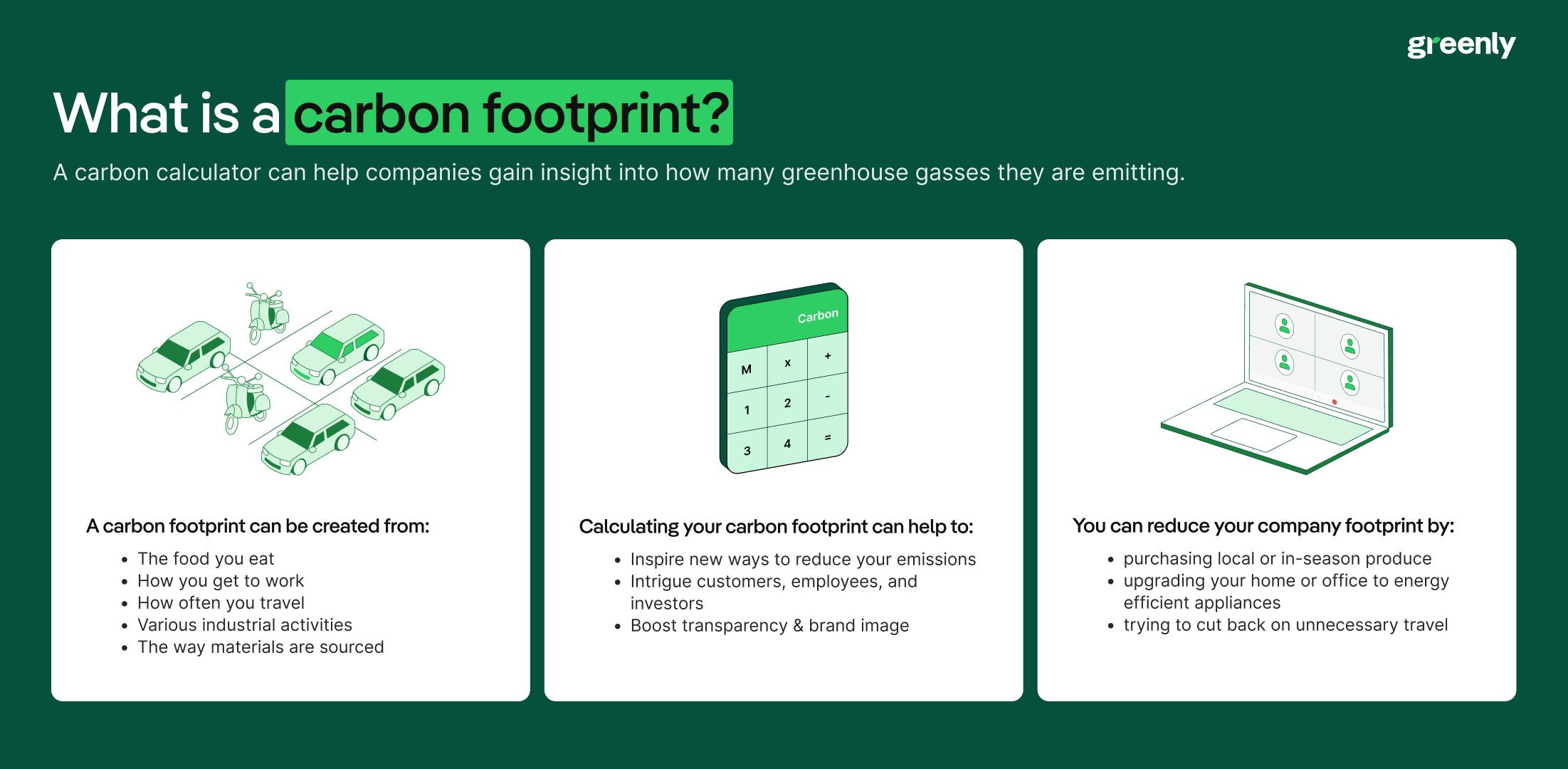

Choosing the right carbon management software is crucial for accurately measuring your business's emissions and implementing effective decarbonization strategies. But with so many platforms available, how do you know which one is the best fit for your company? Here are the key features to look for when selecting carbon management software:
Comprehensive carbon management software should allow you to track all three scopes of emissions. For example, companies like IKEA track all three emission scopes to guide their net-zero strategies.
Scope 1 covers direct emissions from company-owned sources, Scope 2 accounts for indirect emissions from purchased energy, and Scope 3 involves emissions from your supply chain and other indirect sources. Being able to measure emissions across all scopes provides a complete view of your company’s carbon footprint.
The battle cards below will breakdown the differences between scope 1, 2, and 3 emissions:
Managing emissions data can be complex, especially if it's coming from various sources. A good carbon management platform utilises automated data capture to help avoid costly reporting errors, ensures audit-readiness, and builds investor confidence. This can reduce the time and effort needed for manual input in emissions measurement and carbon footprint calculations. Additionally, integration with your existing tools, like ERP systems or energy monitoring software, ensures seamless data flow and more accurate emissions reporting.
Carbon management software should provide in-depth analytics and customisable reports, offering insights into your emissions data. Look for platforms with intuitive dashboards that allow you to visualise progress toward sustainability goals, highlight emission hotspots, and generate reports aligned with international frameworks such as the CDP, GHG Protocol, TCFD, and ISO 14064. These reports are essential for both internal assessments and external sustainability reporting.
The summary cards below will provide a synopsis for each of these international frameworks:
Beyond just tracking emissions, the best carbon management software should offer actionable insights into how your company can reduce its carbon footprint. Decarbonization pathways provide tailored recommendations for emission reductions, from energy efficiency improvements to supply chain adjustments.
For example, a food company might receive insights to reduce energy from the use of refrigerants or how to utilise local suppliers to reduce Scope 3 emissions. These tools help companies transition from measuring emissions to actively reducing them.
As regulations around carbon reporting grow, it’s important that your chosen software is built to support compliance. Whether it’s aligning with the GHG Protocol or ensuring your reports meet the requirements of CSRD, a strong regulatory framework is critical for both compliance and transparency. The software should also offer regular updates as regulations evolve.
By focusing on these key features such as full-scope tracking, automated data integration, and regulatory compliance, businesses can ensure they choose a carbon management software that not only helps them track and measure emissions effectively – but also take strategic climate action to boost business credibility and support their long-term sustainability goals.

Now that we’ve covered why carbon management software is essential and the key features to look for, let’s dive into five leading platforms that are helping businesses tackle their emissions challenges.
Selecting the best carbon accounting software is critical to ensure your organisation meets ambitious climate targets and regulatory mandates.
These platforms offer a range of tools designed to simplify carbon accounting, drive decarbonization efforts, and ensure compliance with global regulations.
Furthermore, the following platforms have been recognised for their innovation, user-friendliness, and ability to support data collection across all three emission scopes – helping to simply the process of calculating a corporate carbon footprint and boost sustainability efforts.
Overview: Greenly offers a comprehensive carbon management platform that helps businesses of all sizes measure and reduce their carbon emissions across Scopes 1, 2, and 3. Developed with ease-of-use, powerful analytics, and accuracy in mind – Greenly has been trusted by over 1,500 organisations across various industries such as finance, retail, and manufacturing. Greenly provides businesses with the tools they need to understand their carbon footprint and take action toward decarbonization.
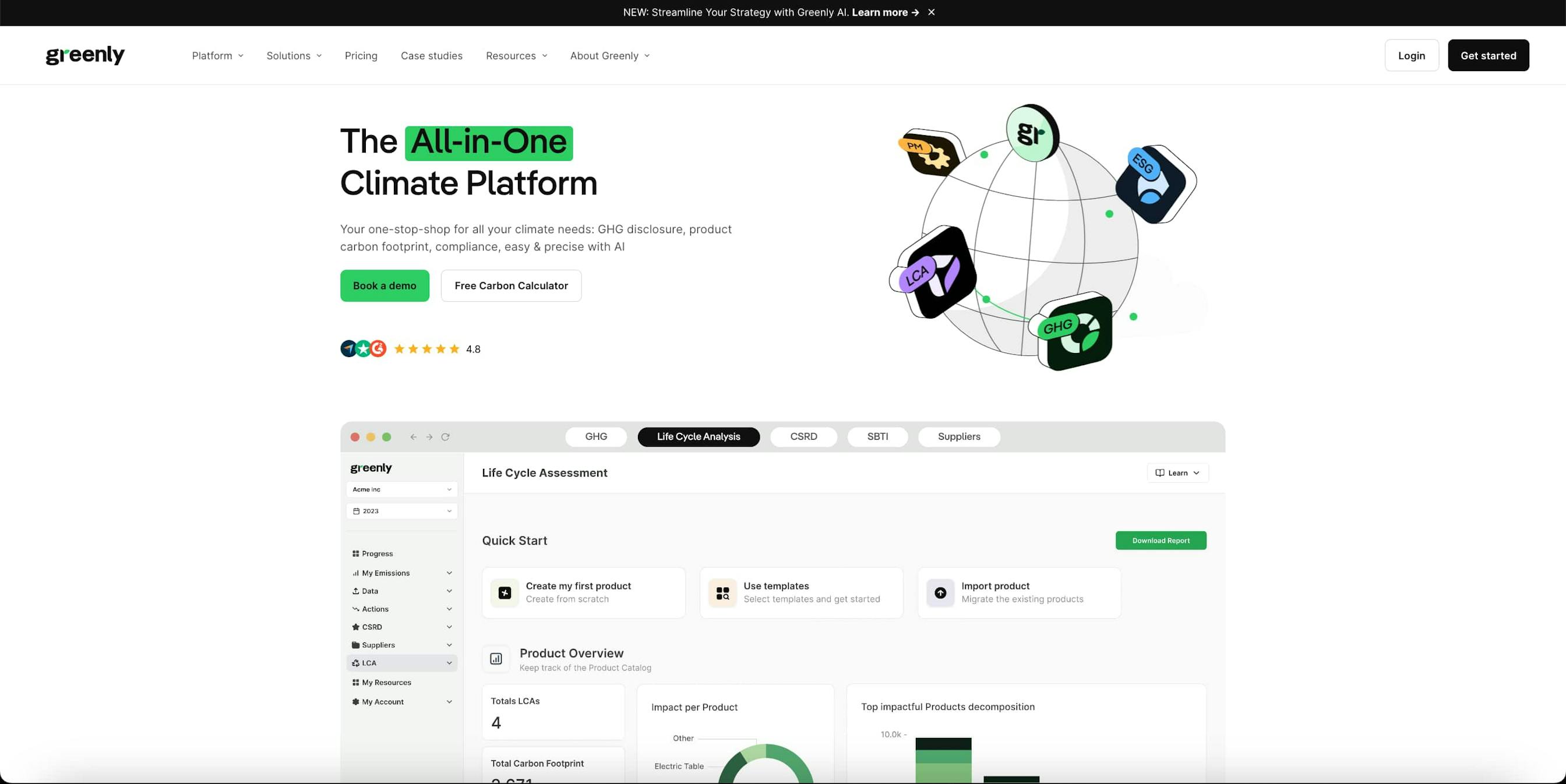
Key Features:
Our platform's credibility is further supported by partnerships with institutions such as ADEME and Bpifrance, and our methodology is aligned with international standards including the GHG Protocol, ISO 14064, and CDP.
Overview: Plan A is TÜV-certified a carbon management platform focused on helping companies decarbonize and navigate strict sustainability regulations such as the EU’s Corporate Sustainability Reporting Directive (CSRD). Plan A goes beyond carbon accounting, offering tailored solutions to help companies report emissions, actively reduce them, and meet sustainability goals.
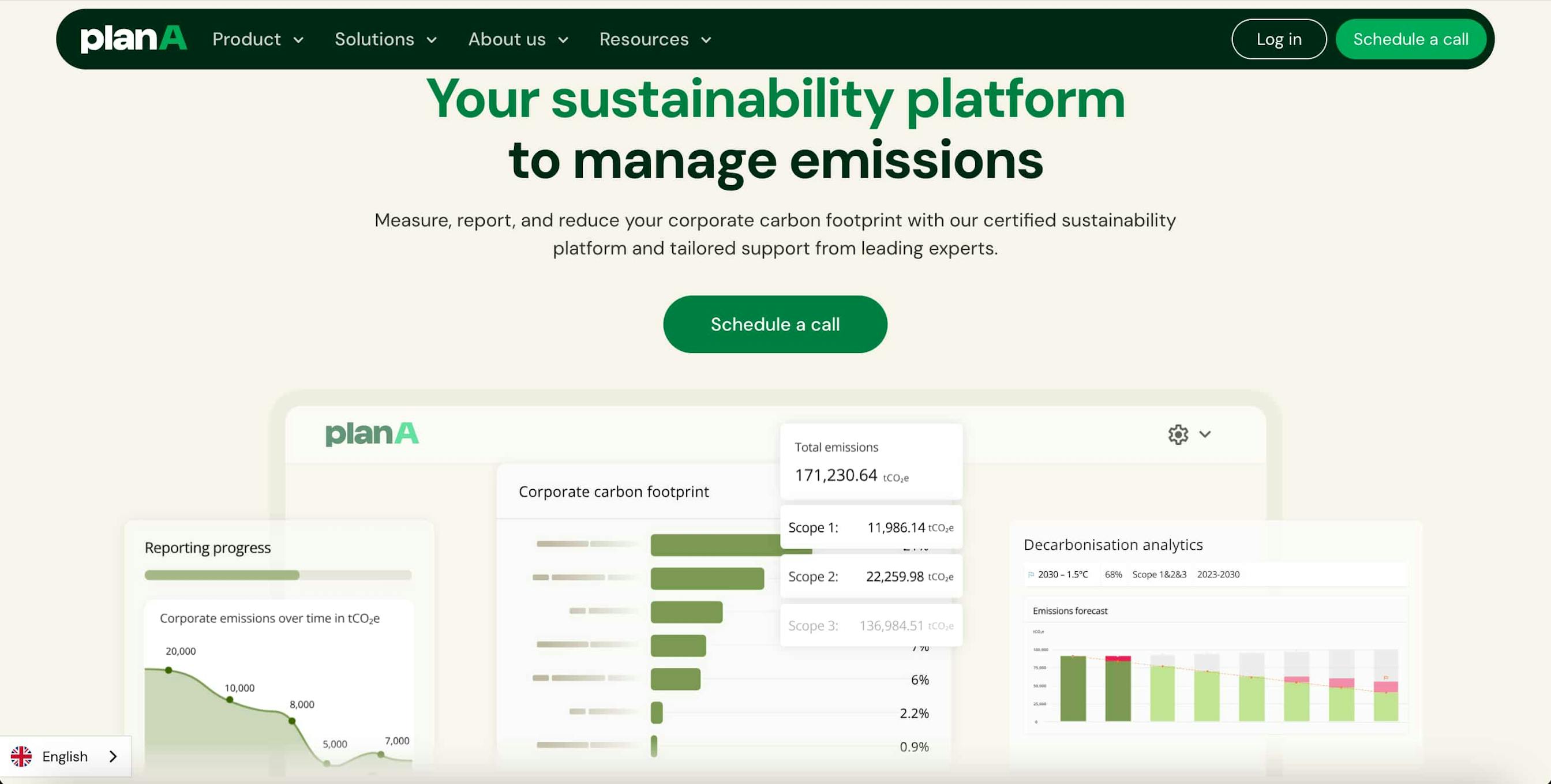
Key Features:
Overview: Watershed is a robust carbon management platform designed for large enterprises with complex supply chains. It offers tools for carbon, water, and waste accounting, making it a comprehensive sustainability solution that excels in Scope 3 emissions management. Watershed’s platform is trusted by businesses across sectors, including finance, consumer goods, and logistics.
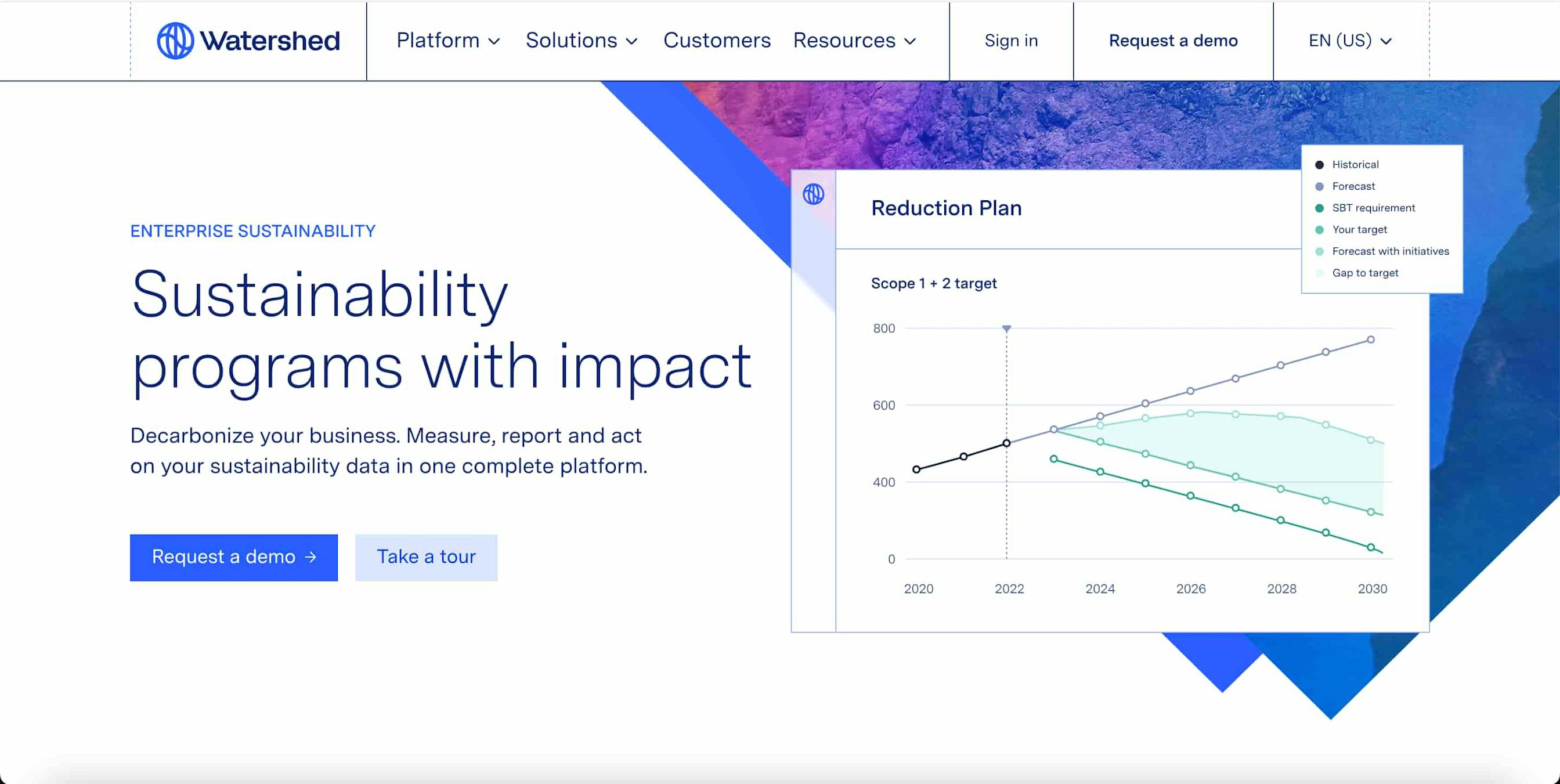
Key Features:
Overview: Sweep is a highly customisable platform known for handling large datasets and integrating sustainability into complex business operations. Its flexibility makes it suitable for organisations of all sizes, from SMEs to large corporations seeking personalised emissions tracking and supplier engagement tools. Built with data integrity and Scope 3 tracking in mind, it’s a strong choice for businesses looking to embed sustainability into every layer of their operations.
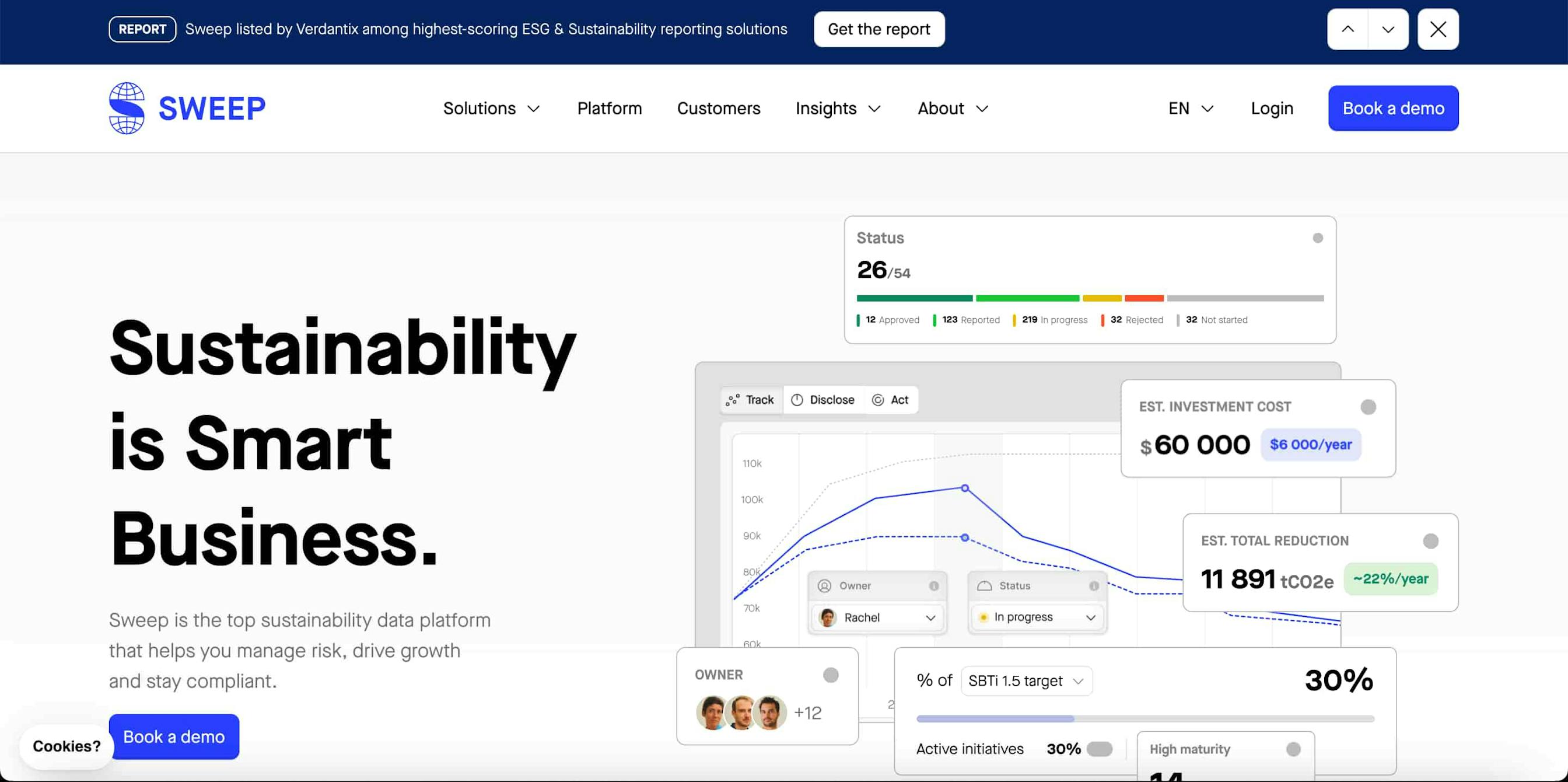
Key Features:

Overview: IBM’s Environmental Intelligence Suite combines carbon accounting with advanced climate data analytics and risk management software. Designed for enterprise-level clients, the platform provides in-depth insights into emissions and strategic risk management aligned with global ESG standards.
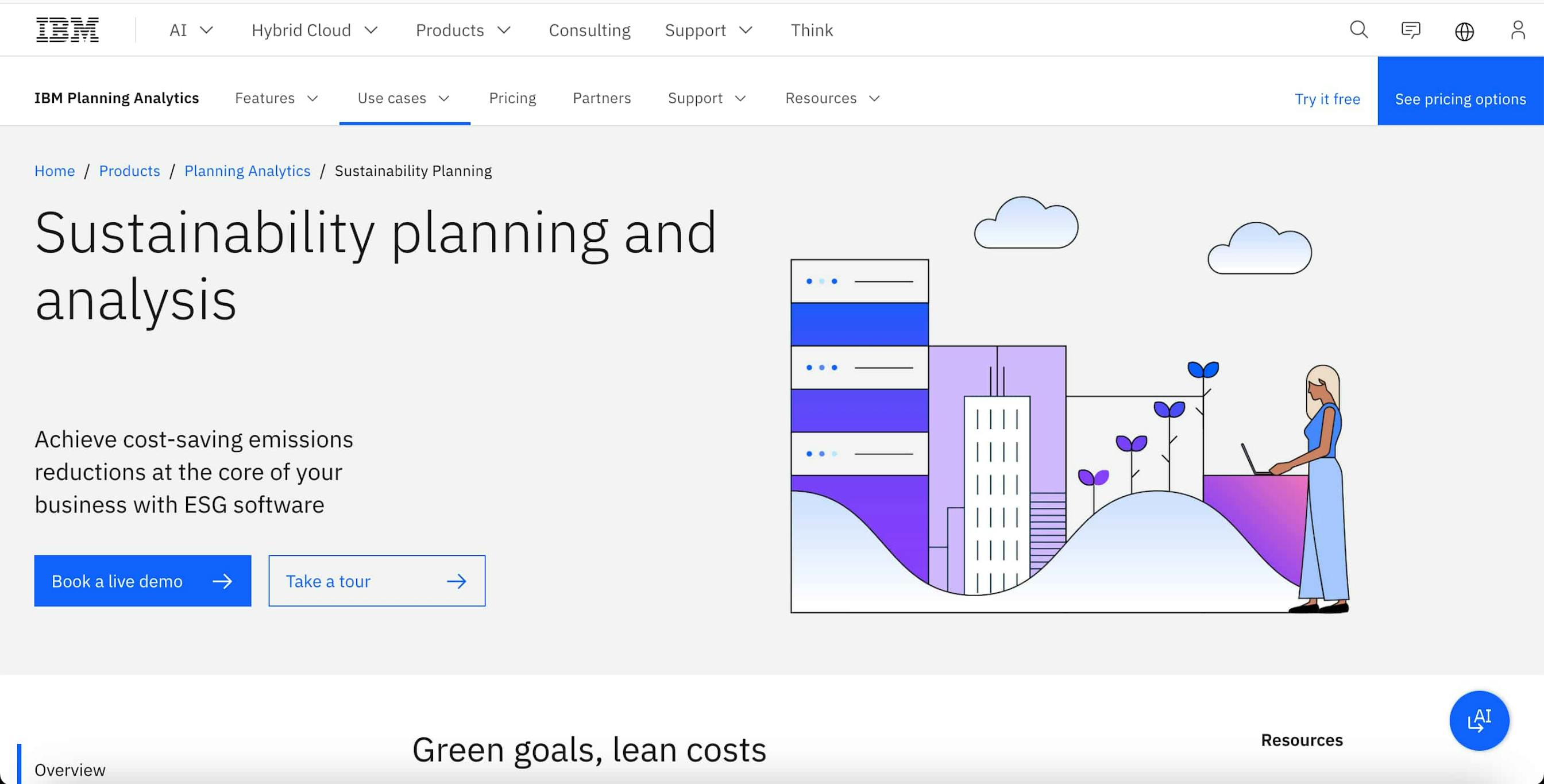
Key Features:
Overview: Persefoni, previously recognised by Forrester as a leader in carbon accounting and climate management, is one of the most viable options for carbon management software – and can prove especially beneficial for enterprises and financial institutions manage and disclose their carbon footprints aligned with GHG Protocol and PCAF standards.
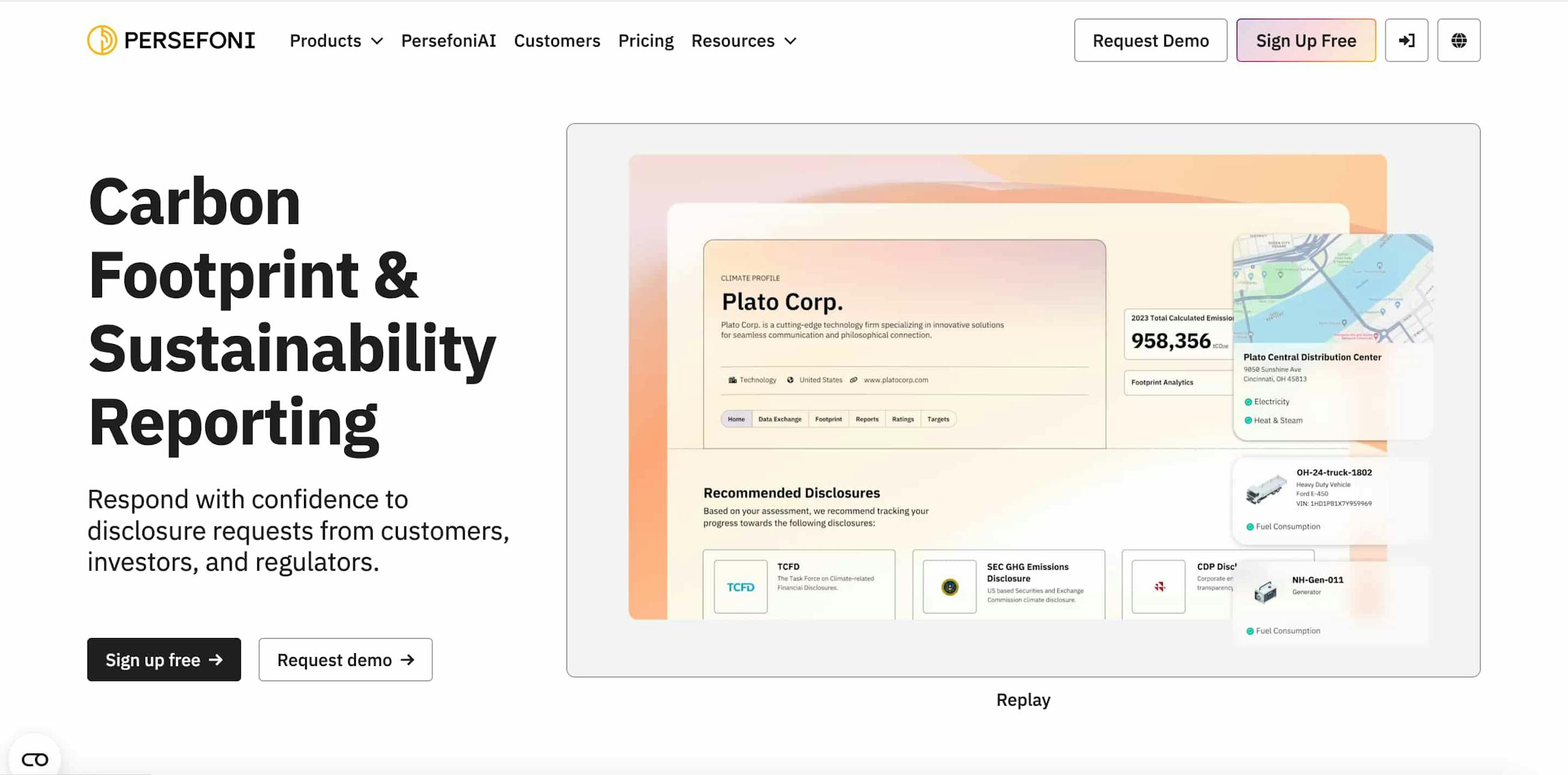
Key Features:
Overview: Founded in New Zealand back in 1994, Diligent was developed with linking the cause-and-effect between risk and compliance in mind – ultimately providing organisations with an outline to ensure their business operates in line with current climate legislation and also allowing for reduced operational costs.
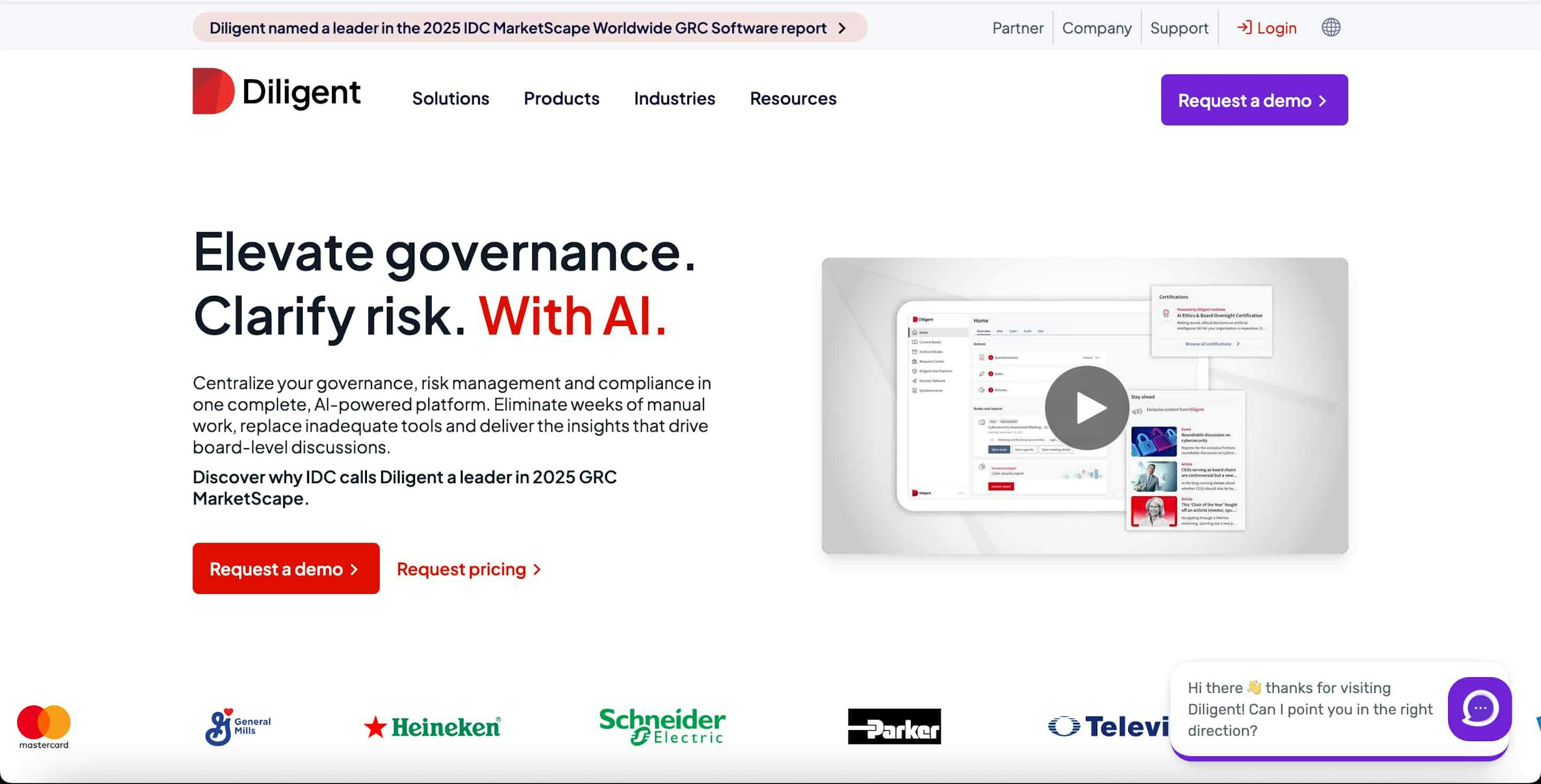
Key Features:

Overview: Sphera is a carbon management platform which utilises ESG (Environmental, Social, and Governance) performance, risk management mechanisms, and lifecycle-based emissions data to provide industry-specific modeling to effectively track, reduce, and comply with climate-related regulations.
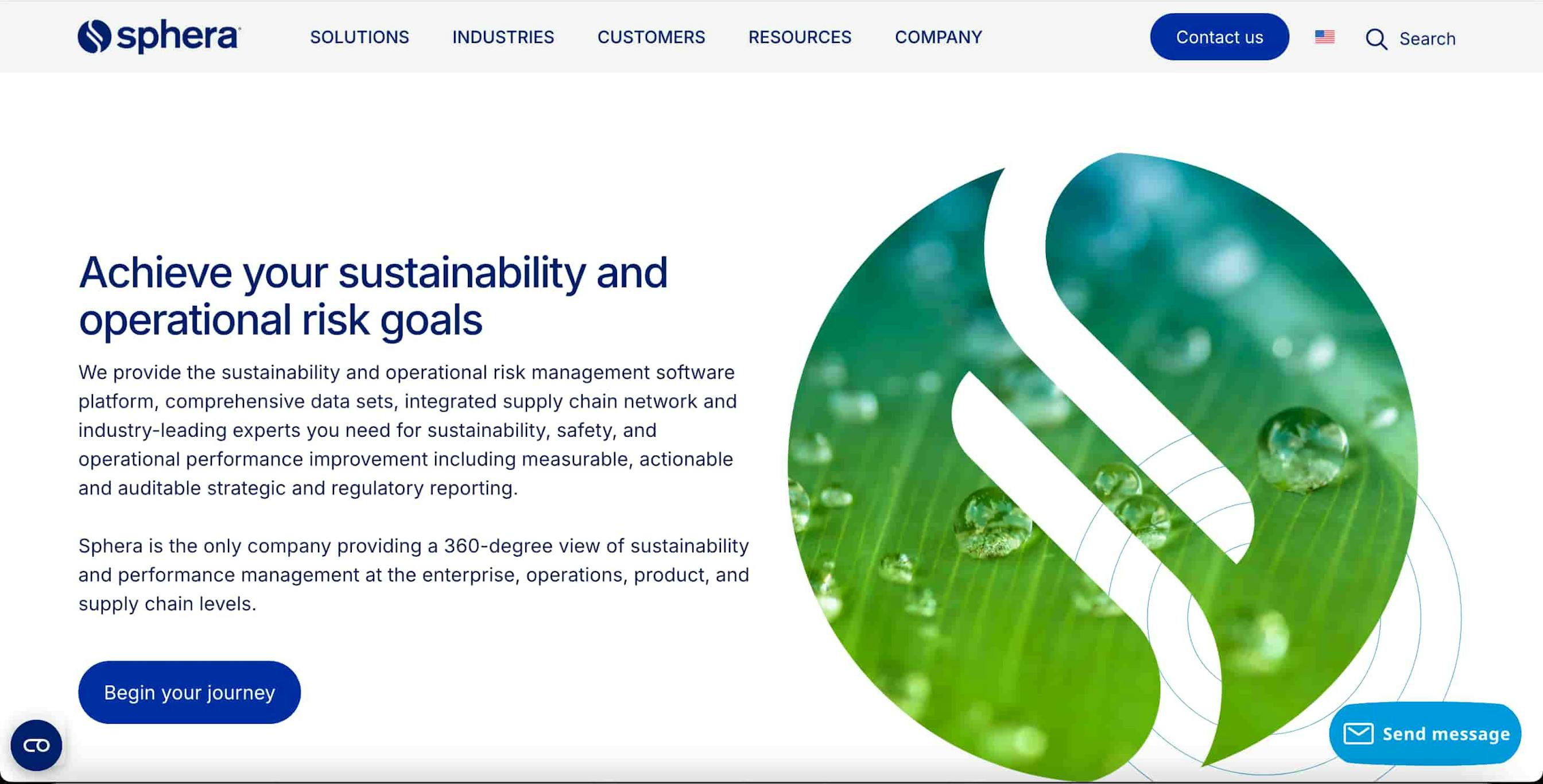
Key Features:
Overview: Developed by Salesforce, Net Zero Cloud can assist organisations in tracking and reducing emissions, overseeing energy usage, and provide supply chain sustainability metrics with built-in collaboration tools al Salesforce's automation, language support, and integration features
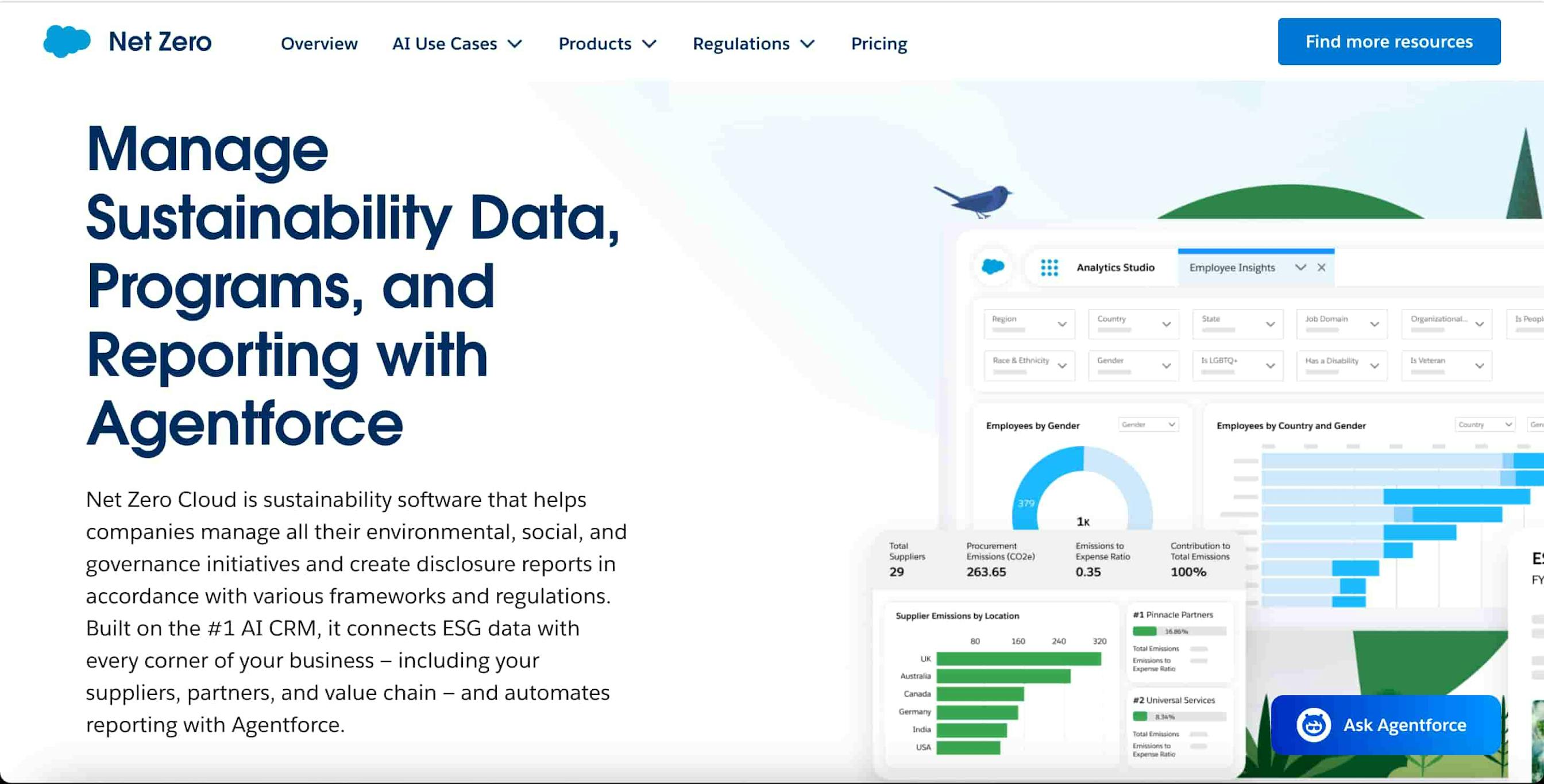
Key Features:
Overview: Formerly known as Microsoft’s Cloud for Sustainability, Microsoft’s Sustainability Manager empowers organisations to monitor and manage emissions via robust data integration with the help of Azure, Power BI, and Dynamics.
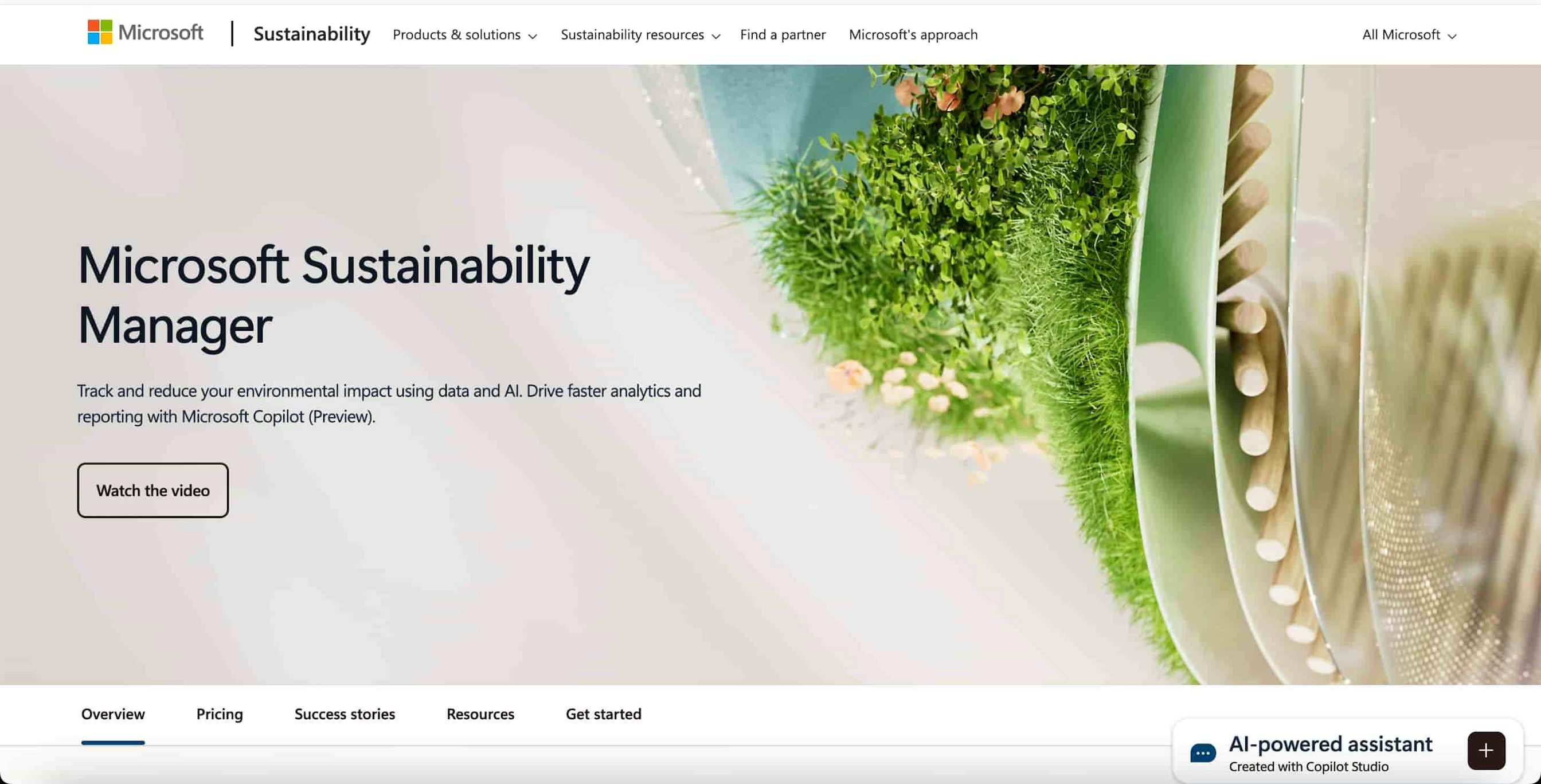
Key Features:
The table below will compare and contrast these carbon accounting platforms:
| Platform | Overview | Key Strength | Best For |
|---|---|---|---|
| Greenly | Comprehensive platform focusing on Scope 1, 2, and 3 emissions tracking, tailored strategies, and supply chain decarbonisation. | User-friendly platform with tailored action plans and comprehensive supply chain decarbonisation tools. | Businesses of all sizes looking to track and reduce carbon emissions with expert support. |
| Plan A | European-focused platform prioritising decarbonisation with TÜV-certified tools, aligned with CSRD compliance. | Decarbonisation-first approach with compliance to major European regulations like CSRD. | European companies needing strong decarbonisation strategies and regulatory compliance. |
| Watershed | Robust platform for large enterprises with a focus on managing complex supply chains and multi-category environmental impacts. | Specialises in Scope 3 tracking and sustainability across supply chains, water, and waste accounting. | Large businesses with complex supply chains and multi-category environmental impacts. |
| Sweep | Highly customisable platform, suitable for businesses of all sizes, known for its strong Scope 3 emissions tracking. | Customisable reporting and advanced Scope 3 visibility, strong analytics for businesses of all sizes. | Companies seeking flexible, customisable tools for detailed carbon management. |
| IBM Environmental Intelligence Suite | Enterprise-level platform combining carbon accounting with climate data analytics and risk management. | Advanced climate analytics with future emissions projections and risk management. | Large enterprises needing a combination of carbon management and climate risk planning. |
| Persefoni | Recognised by Forrester as a leader in carbon accounting, Persefoni supports enterprises and financial institutions with AI-powered emissions tracking and TCFD climate scenario modeling. | Expert advisory board and investor-grade reporting aligned with GHG Protocol and PCAF standards. | Companies needing audit-ready disclosures and advanced climate scenario analysis. |
| Diligent | Founded in New Zealand, Diligent connects risk and compliance with real-time emissions tracking to help reduce costs and meet environmental regulations. | Live audit insights and automated risk management tools for proactive regulatory alignment. | Executives, nonprofits, and governments focused on climate risk and compliance. |
| Sphera | Carbon platform driven by ESG and lifecycle-based emissions data, enabling centralised data collection and regulation-aligned compliance across industries. | Deep LCA expertise, strong regulatory compliance tools, and industry-specific emissions modeling. | Manufacturing-intensive companies seeking product-level carbon insights and LCA training. |
| Net Zero Cloud by Salesforce | Salesforce’s carbon tracking platform enables organisations to measure emissions, optimise energy usage, and collaborate with suppliers using integrated tools. | AI-powered report generation, seamless Salesforce integration, and robust connectivity. | Salesforce-centric businesses centralising carbon, CRM, and ESG data in one platform. |
| Microsoft Sustainability Management | Built on Azure and Power BI, Microsoft’s cloud-based platform helps businesses monitor emissions and automate sustainability workflows. | Embedded tools for ESG governance, real-time data integration, and automated emissions tracking. | Microsoft-based organisations seeking automated sustainability tools integrated with existing software. |
Choosing the right carbon management software is about finding the platform that best aligns with your business’s specific goals, operations, and sustainability ambitions.
Here’s how you can approach the decision-making process to ensure you make the right choice:
Before selecting a software platform, it’s crucial to have a clear understanding of your business’s emissions sources.
Are most of your emissions concentrated in Scope 1 and 2, or is Scope 3 (supply chain and indirect emissions) a significant component?
Knowing where your emissions are coming from will help you choose a platform with the right capabilities to address your carbon reduction strategies more effectively.
Are you aiming to comply with regulations, or do you want to go beyond compliance and set ambitious decarbonization targets?
Some businesses may need software to simply track emissions for ESG reporting purposes, while others are looking to take a more proactive approach to reduce emissions in line with net-zero goals.
Choose a platform that aligns with the level of ambition you have for your sustainability journey.
Different industries have unique carbon management challenges.
For example, manufacturers may need tools that can track emissions across complex supply chains, while service-based businesses might prioritise energy use and operational efficiency.
Some platforms offer industry-specific solutions, such as safety and liability reduction, meaning it’s important to choose one that caters to your sector’s requirements and can deliver actionable insights tailored to your operations.
If you’re new to carbon management, you might need a software provider that offers comprehensive expert support, from helping with emissions calculations to guiding your decarbonization strategy.
On the other hand, if your sustainability team is experienced, you may prioritise platforms that offer greater flexibility and autonomy.
Consider how much support your business will need to get the most value from the platform.
While immediate needs are important, think about the future scalability of the platform. Will the software be able to grow with your company as your carbon management strategy evolves?
Consider platforms that offer modular or scalable solutions that can adapt as your business expands, new regulations emerge, or sustainability goals become more ambitious.
Finally, ensure that the software integrates smoothly with your existing systems - whether it’s your financial software, energy management platforms, or supply chain management tools.
A platform that supports seamless data flow will save you time and provide more accurate, real-time insights.
For businesses looking to take meaningful steps toward reducing their carbon footprint, Greenly offers comprehensive carbon management solutions tailored to your unique needs.
Our advanced platform allows companies to:
Greenly’s intuitive platform streamlines the process of managing emissions, allowing you to monitor progress and integrate sustainability into your operations. From tailored action plans that drive emissions reduction to tools that decarbonize your supply chain, Greenly is with you every step of the way.
We know that there are a lot of carbon management platforms to choose from, and that it can be confusing to pinpoint the most effective software – but the table below will compare and contrast what Greenly can offer as opposed to our competitors:
| Feature | Greenly | Coolest | Normative | Watershed | Sweep | Plan A |
|---|---|---|---|---|---|---|
| Scope 3 + Uncertainty | Full upstream & downstream Scope 3 tracking with uncertainty ranges and deep methodology transparency. | Partial, no uncertainty. | Strong tracking + uncertainty. | Partial, lacks visibility. | Core only, low detail. | No variance metrics. |
| Carbon Pricing Tools | Comparative GHG risk evaluation including pricing forecasts and scenario modeling to assess future cost exposure. | No pricing logic. | Included in premium tier. | Basic pricing model. | Carbon pricing tool beta. | Pricing not included. |
| Emission Factors & Guidance | Extensive emission factor database + clear user guidance for tailored, sector-specific calculations. | Static factors only. | Up-to-date and adaptable. | Partial factor customisation. | Fixed default factors. | Basic factor library. |
| Offset Opportunities | Access to certified, transparent carbon offset projects with customisable options per client impact model. | Not integrated. | Offset partners available. | Limited project options. | Basic offset offering. | Few curated options. |
| Communication Tools | Medal-based badge system for clear sustainability progress communication and stakeholder visibility. | PDF summary only. | Internal dashboards. | Basic progress report. | Limited visualisation. | No badge system. |
| IT & Data Security | Robust IT security architecture including SOC2 compliance and enterprise-grade encryption. | Minimal security detail. | Strong standards. | Enterprise-grade. | Some certifications. | Basic protocols. |
| Reporting & Compliance | Custom reports aligned with GHG Protocol, CSRD, CDP, and other frameworks—perfect for audits, compliance, or investor comms. | Manual reporting only. | Advanced reporting tools. | Templates provided. | Good CSRD templates. | Limited customisation. |
| SBTi Alignment | Step-by-step support with SBTi application from submission to approval, including a compliant roadmap and ongoing guidance. | General templates, low guidance. | Strong but not tailored. | Limited guidance. | Basic resources only. | Structured roadmap, mid-level. |
| CSRD Compliance | Deep EU-native expertise with materiality & double materiality assessments. Ideal for international reporting. | Minimal CSRD focus. | Strong tools, good materiality. | Covered, but shallow. | Fair automation. | Good prep, non-EU native. |
| LCA & Eco-Design | PEF-aligned templates, sector-specific database, and design guidelines to support eco-design alignment. | Basic, low detail. | Advanced models. | Template-driven. | Simple, lacks design. | PEF-aware, light automation. |
With end-to-end support, expert insights, and user-friendly technology, Greenly helps your business not only meet its sustainability goals but also drive long-term value by enhancing brand reputation and building investor confidence.
Start your journey toward a more sustainable future with Greenly today.
A: Greenly is an excellent choice for carbon management. We offer broad support to both reduce your emissions and build long-term sustainability: personalised climate experts to help you engage stakeholders, user-friendly dashboards to monitor and manage progress, and help complying with the latest regulations (Legislation Checker). You’ll also get step-by-step assistance for complex standards such as the CSRD or applying to the SBTi.
A: Yes! Greenly is perfect for SMEs. Our platform supports improved supplier engagement, LCA assessments, guidance for regulatory compliance, and additional resources—giving growing companies everything they need to launch and scale sustainable strategies the right way.
A: Greenly ensures accuracy using a hybrid of the spend-based and activity-based methods, combined with streamlined, verifiable data collection. This helps ensure nothing is missed and that calculations across all scopes are precise and audit-ready.
A: Greenly offers automated data collection, supplier engagement via a user-friendly portal, and structured surveys/questionnaires to keep data current—so your carbon reduction strategy can be adjusted as needed. In addition, our Quick Carbon Calculator provides a free, reliable snapshot of your footprint in under 15 questions—with results in minutes.
A: The Quick Carbon Calculator can’t guarantee real-time data because its output depends on the responses provided. However, a full Greenly subscription enables real-time data visualisation and monitoring—supporting the most approachable and robust carbon-reduction roadmaps possible.
